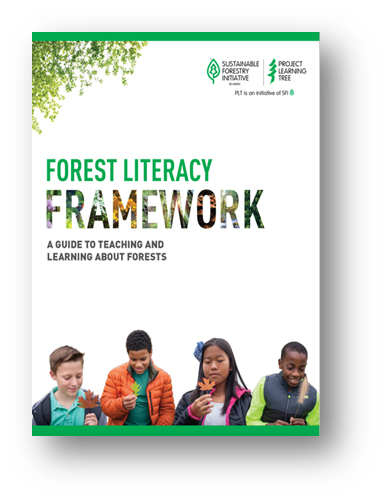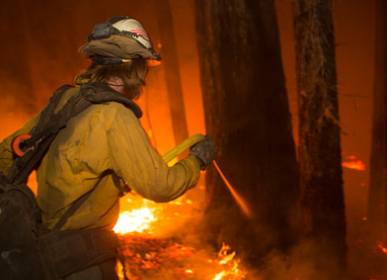July 8, 2021
 Project Learning Tree’s new Forest Literacy Framework translates the complex language of forests, trees, forest practices, and sustainable forest management into concepts that everyone should know by the time they graduate from high school. It is designed to increase people’s understanding of forests and empower them to take actions that benefit forests and people.
Project Learning Tree’s new Forest Literacy Framework translates the complex language of forests, trees, forest practices, and sustainable forest management into concepts that everyone should know by the time they graduate from high school. It is designed to increase people’s understanding of forests and empower them to take actions that benefit forests and people.
Forests and our shared future
Our collective future will depend on people better understanding the values and benefits of forests because they are so important to solving global challenges. Forests mitigate climate change by capturing carbon from the atmosphere and wood products from forests store carbon. Forests help conserve species at risk by providing habitat. Forests also purify air and water and reduce the threat of droughts and floods.
Forests are renewable. They are reliable, regenerative, and restorative. Forests sustain communities and economies by supporting diverse career opportunities and driving economic activity. Providing recreational spaces and sustaining traditional resource uses and places for spiritual renewal are yet other areas where forests play an outsized role.
PLT’s Forest Literacy Framework (or FLF) distills this essential knowledge into age-appropriate core concepts that can be applied in formal or informal settings. It benefits youth, educators, and communities large and small.
The Forest Literacy Framework was jointly developed by PLT and PLT Canada, with partial funding from the USDA Forest Service. Input from a 16-person Advisory Panel represented a wide spectrum of stakeholder engagement and ensured content accuracy, age-level appropriateness, and bi-national continuity. PLT’s Forest Literacy Framework is a natural extension of the Oregon Forest Resources Institute’s Forest Literacy Plan, which developed the concept.
Three Options to Engage
The Forest Literacy Framework offers three options for starting your forest literary journey. Download the complete Forest Literacy Framework or connect to each section by grade level, hot topic, and theme below. Have a look to decide which way(s) work best for you:
1.) Start with an engaging question
 To use this approach, focus on pages 8–17 or go to the section on Themes at www.plt.org/forestliteracy, where you will see Forest Literacy Framework concepts organized by four overarching themes:
To use this approach, focus on pages 8–17 or go to the section on Themes at www.plt.org/forestliteracy, where you will see Forest Literacy Framework concepts organized by four overarching themes:
- Theme 1: What Is a Forest?
- Theme 2: Why Do Forests Matter?
- Theme 3: How Do We Sustain Our Forests?
- Theme 4: What is Our Responsibility to Forests?
These questions can be used as engaging phenomena to connect students to learning in meaningful ways. Leading with phenomena directly connects instruction to learners’ homes, communities, and cultures, thus making teaching and learning more diverse, inclusive, and relevant. Once you’ve chosen the theme you want to focus on, visit that section in the FLF to dive deeper into sub-themes and concepts to explore.
2.) Start with an age or grade level
![]()
To leverage this approach, visit pages 20–35 or select the age and grade level of your learners at www.plt.org/forestliteracy. This section of the resource explores forest concepts and topics that are most appropriate for the grades/ages with whom you work.
While this section is organized by grade level, it is important to recognize that these lines are not hard and fast. Learning represents a continuum, and you always have options to differentiate instruction for your target audience.
The grade-level sections provide guiding questions to help construct teaching and learning about trees and forests. Other resources in this section include connections to subject areas, topics, core ideas, and academic standards; age-appropriate, hands-on examples; and real-world connections to community programs or other resources.
3.) Start with a current event or hot topic

Last but not least, pages 36–40 of the framework address forest concepts by “hot topic.” You can also connect directly to the Hot Topics section at www.plt.org/forestliteracy.
We have five topics available now:
- Urban Forests
- Climate Change
- Green Jobs
- Wildfire
- Public Health
Once you’ve selected the topic, you’ll be guided by concept and grade level to use the topic as a hook to forest concepts. A sixth topic, Indigenous Connection To Land, is under development, and others are planned.
Connections with Explore Your Environment
You may be wondering how the Forest Literary Framework relates to PLT’s new Explore Your Environment: K-8 Activity Guide. Both resources reference one another, so you can easily see how different PLT activities reinforce forest literacy concepts.
What’s more, our new online professional development (launching in August!) takes participants through three activities that advance the understanding of the themes presented in the Forest Literacy Framework. The online course also connects the hot topics detailed above with the 50 hands-on activities in Explore Your Environment.
Continue the Conversation
The Forest Literacy Framework is a living document, always changing and evolving. Please consider sharing and helping to improve it by completing a three-question online survey!


